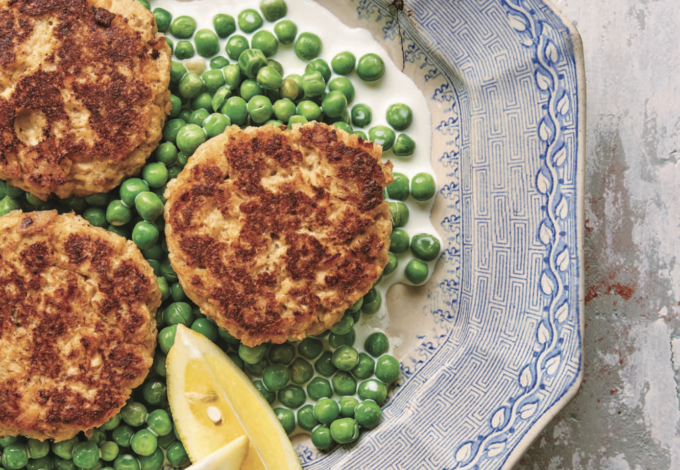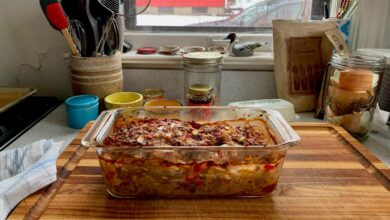Social Anxiety and the Power of Potato Chips

[ad_1]
When I’ve been at my most anxious, I’ve felt like life is one long grocery list that includes something I need that I can’t find anywhere…
Sometimes I think I was born with a list of things I was worried about (epigenetic inheritance is real!) and sometimes I think I do a very good job of finding new things to worry about all by myself. In addition to therapy, sleep, physical activity (whether it’s walking or exercise or gardening), and talking to my wife and my friends, cooking has also been a majorly calming force in my life. While food has definitely brought up plenty to make me anxious about, making it has been the most consistent tool I have to help me feel grounded.
Food has always helped me walk through doors that feel scary. I didn’t attend many parties in high school, so when I first got to college and my new friends invited me to go to parties, I smiled and said yes while I quietly panicked inside. Be comfortable at a party? Hang out with people from school besides at school? I wasn’t so sure about that.
Being someone who doesn’t like to arrive anywhere empty-handed, even a college house party, I quickly learned that I could assuage my social anxiety if I stopped at the corner deli, bought the biggest bag of potato chips I could find, and brought them with me. They gave me an easy way to walk up to people without feeling totally awkward. “Want a potato chip?” felt a lot easier than saying “hello.” Sure, it was a shtick, but the chips gave me a way in. I eventually became comfortable at parties and other occasions without a bag of chips, but the chips helped pave that comfort.
The other way I’ve always gone about making friends is inviting people over for a meal. In fact, when I moved into my freshman dorm, I brought a pot and a toolbox filled with basic kitchen tools so it would be easy to take them in and out of the communal kitchen. Those tools, a wooden spoon and a peeler and tongs and such, made me feel like I had the things I needed to do something I loved to do in a place that felt so unfamiliar. They made me feel secure. I made spaghetti for my floor mates and roasted chicken in disposable aluminum pans from the grocery store. It was a way to extend myself to my new community.
When I moved into an apartment off campus, I saved up money to buy my first sturdy Dutch oven. I remember a friend telling me that my pot was “so grown up.” It made me feel adult when I wasn’t so sure what that was (still don’t always know, by the way). Cooking not only calmed me, it also helped me feel like I could make the big world I found myself in feel a little bit smaller.
Anxiety, like many complicated things, has so many edges. When I need to exit a stressful setting, or group of people, cooking also lets me do that. In other words, it’s not just a way to connect, it’s also a way to disconnect. You can always leave your dining room table to do some dishes or to “get dessert ready” even if it’s already ready. The kitchen can be a place to take a breath. It’s part of why I love grilling so much. It means I get to be outside while everyone is inside. I’m still part of the party, I’m making the food!, but I get to be a little bit at arm’s length. And sometimes, that’s exactly where I feel most calm.
When I talk to other people about anxiety, I always like to find out when people feel most themselves, most free of worry. For me, it’s when I’m standing in my kitchen by myself cooking because I feel like it, not because I need to. There’s music playing. I can hear my wife doing something in the other room. I can see our dogs lazily napping on the bench by the kitchen window. I am chopping vegetables, doing the thing that so many other people are doing at the same time around the world. I am alone, but I am also in solidarity. I am content and present. I know what I’m making and have everything I need to do so. I don’t care if it turns out perfectly. It’s just dinner. I’m worried about nothing.
Ricotta and Potato Chip Fish Cakes with Peas
From the new cookbook Simply Julia
An homage to the salmon patties I got to enjoy one morning at Narobia’s Grits & Gravy in Savannah, Georgia (which, sadly, has since closed), these fish cakes rely on canned salmon, one of the most convenient and reliable things to keep in your cupboard. After you brown the fish cakes, you add some frozen peas and half-and-half to the skillet, which makes a bright green bed for the fish cakes. You could also skip the peas and serve the fish cakes on toasted potato buns slicked with mayonnaise and piled with shredded lettuce and sliced pickles.
Serves 4
One 2-ounce bag potato chips (preferably sour cream and onion-flavored)
Two 6-ounce cans wild pink salmon packed in water, well-drained
1 cup whole milk ricotta cheese
1 tablespoon Old Bay seasoning (or 1 teaspoon each kosher salt, sweet paprika, and garlic powder)
1 lemon
2 tablespoons unsalted butter
One 10-ounce package frozen peas
½ cup half-and-half
½ teaspoon kosher salt
Let some air out of the potato chip bag and then crush the bag with a rolling pin or wine bottle to make fine crumbs. Transfer the potato chip crumbs to a large bowl and add the salmon, ricotta, and Old Bay. Finely grate the zest from the lemon and add it to the bowl (reserve the zested lemon). Stir the mixture well to combine, really breaking up the salmon as you mix.
Divide the mixture into 8 equal portions and use your hands to form each into a patty. It’s helpful to divide the mixture in half and then in half againand so on to make sure the patties are the same size.
Place the butter in a large nonstick skillet over medium-high heat. Once it melts and begins to bubble, place the fish cakes in the skillet and cook without disturbing them until their bottoms are nicely browned (what a sentence!), 2 to 3 minutes. Use a spatula to carefully flip each one over and cook until nicely browned on the second side, another 2 to 3 minutes. You might need to cook the fish cakes in 2 batches depending on the size of your pan (you don’t want to crowd the pan, and definitely give yourself space to flip them—think of the spacing like pancakes). Transfer the fish cakes to a plate and cover them with foil to keep them warm.
Turn the heat to high and place the peas, half-and-half, and salt in the same skillet. Cook, stirring, just until the peas are bright green and tender andthe half-and-half has reduced slightly, about 4 minutes. Transfer the saucy peas to a serving platter and place the fish cakes on top. Cut the zested lemon into wedges and serve the wedges with the fish cakes for squeezing over. Serve immediately.
Thank you, Julia! We love your book.
(This essay and recipe was reprinted from the new cookbook Simply Julia with permission. Photos by Melina Hammer.)
[ad_2]
Source link








